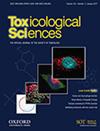HFPO-DA 与原型 PPARα、PPARγ 和细胞毒性药物在小鼠、大鼠和集合人类肝细胞中的转录组特征比较
IF 3.4
3区 医学
Q2 TOXICOLOGY
引用次数: 0
摘要
与许多全氟或多氟烷基物质(PFAS)一样,HFPO-DA(2,3,3,3-四氟-2-(七氟丙氧基)-丙酸铵)是一种短链 PFAS,用于制造某些类型的含氟聚合物,对其进行的毒性研究表明,啮齿类动物经口接触后,肝脏是毒性的主要靶标。尽管目前的证据支持 PPARα 作用模式 (MOA)对暴露于 HFPO-DA 的小鼠的肝脏产生影响,但也提出了其他作用模式的假设,包括 PPARγ 或细胞毒性。为了进一步评估 HFPO-DA 在啮齿动物肝脏中的作用方式,我们对小鼠、大鼠和人类肝细胞样本进行了转录组学分析,这些样本分别接受不同浓度的 HFPO-DA、PPARα 激动剂(GW7647)、PPARγ 激动剂(罗格列酮)或细胞毒性药物(即对乙酰氨基酚或 d-半乳糖胺)处理 12、24 或 72 小时。对每个物种中不同化学物质富集途径的一致性分析表明,与其他评估的化学物质相比,HFPO-DA 和 PPARα 激动剂 GW7647 处理的肝细胞之间的一致性最高。这些发现得到了基准浓度建模和上游调节剂预测结果的支持。此外,不同物种的转录组分析表明,用 HFPO-DA 或 PPARα 或 PPARγ 激动剂处理的啮齿类动物肝细胞的转录组反应更大,这表明啮齿类动物肝细胞对 HFPO-DA 或 PPARα/γ 激动剂处理更敏感。这些结果与之前发表的转录组分析结果一致,并进一步支持了暴露于 HFPO-DA 的啮齿动物的肝脏效应是通过啮齿动物特异性 PPARα 信号机制介导的,是 PPARα 激活剂诱导啮齿动物肝癌发生的 MOA 的一部分。因此,在人类健康风险评估中,在小鼠肝脏中观察到的影响并不适合作为制定 HFPO-DA 毒性值的终点。本文章由计算机程序翻译,如有差异,请以英文原文为准。
Comparison of transcriptomic profiles between HFPO-DA and prototypical PPARα, PPARγ, and cytotoxic agents in mouse, rat, and pooled human hepatocytes
Like many per- or polyfluorinated alkyl substances (PFAS), toxicity studies with HFPO-DA (ammonium, 2,3,3,3-tetrafluoro-2-(heptafluoropropoxy)-propanoate), a short-chain PFAS used in the manufacture of some types of fluorinated polymers, indicate that the liver is the primary target of toxicity in rodents following oral exposure. Although the current weight of evidence supports the PPARα mode of action (MOA) for liver effects in HFPO-DA-exposed mice, alternate MOAs have also been hypothesized including PPARγ or cytotoxicity. To further evaluate the MOA for HFPO-DA in rodent liver, transcriptomic analyses were conducted on samples from primary mouse, rat and pooled human hepatocytes treated for 12, 24 or 72 hours with various concentrations of HFPO-DA, or agonists of PPARα (GW7647), PPARγ (rosiglitazone), or cytotoxic agents (ie, acetaminophen or d-galactosamine). Concordance analyses of enriched pathways across chemicals within each species demonstrated greatest concordance between HFPO-DA and PPARα agonist GW7647-treated hepatocytes compared to the other chemicals evaluated. These findings were supported by benchmark concentration modeling and predicted upstream regulator results. In addition, transcriptomic analyses across species demonstrated a greater transcriptomic response in rodent hepatocytes treated with HFPO-DA or agonists of PPARα or PPARγ, indicating rodent hepatocytes are more sensitive to HFPO-DA or PPARα/γ agonist treatment. These results are consistent with previously published transcriptomic analyses and further support that liver effects in HFPO-DA-exposed rodents are mediated through rodent-specific PPARα signaling mechanisms as part of the MOA for PPARα activator-induced rodent hepatocarcinogenesis. Thus, effects observed in mouse liver are not appropriate endpoints for toxicity value development for HFPO-DA in human health risk assessment.
求助全文
通过发布文献求助,成功后即可免费获取论文全文。
去求助
来源期刊

Toxicological Sciences
医学-毒理学
CiteScore
7.70
自引率
7.90%
发文量
118
审稿时长
1.5 months
期刊介绍:
The mission of Toxicological Sciences, the official journal of the Society of Toxicology, is to publish a broad spectrum of impactful research in the field of toxicology.
The primary focus of Toxicological Sciences is on original research articles. The journal also provides expert insight via contemporary and systematic reviews, as well as forum articles and editorial content that addresses important topics in the field.
The scope of Toxicological Sciences is focused on a broad spectrum of impactful toxicological research that will advance the multidisciplinary field of toxicology ranging from basic research to model development and application, and decision making. Submissions will include diverse technologies and approaches including, but not limited to: bioinformatics and computational biology, biochemistry, exposure science, histopathology, mass spectrometry, molecular biology, population-based sciences, tissue and cell-based systems, and whole-animal studies. Integrative approaches that combine realistic exposure scenarios with impactful analyses that move the field forward are encouraged.
 求助内容:
求助内容: 应助结果提醒方式:
应助结果提醒方式:


